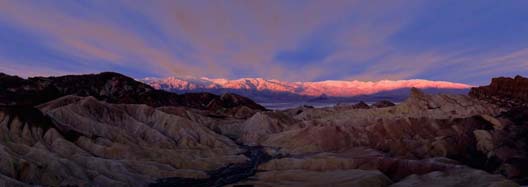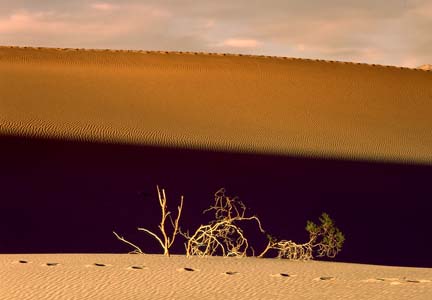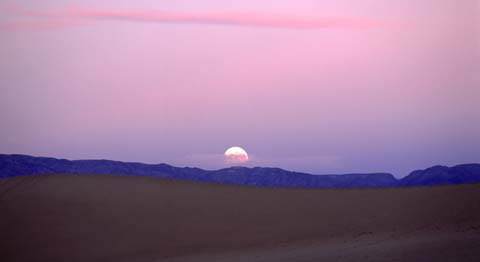![]() This subject is featured inIssue #1of The Luminous Landscape Video Journal
This subject is featured inIssue #1of The Luminous Landscape Video Journal
Death Valley is a place of myth, history and stark beauty. For the landscape photographer there are few places in the American Southwest that offer so much variety and contrast in such a relatively small area. I have now shot there twice, 2 years apart. Additional images from my most recent visit in 1999 can be foundhere.
Getting There and Where to Stay
The Valley is about a 3 hour drive from Las Vegas. The quickest route is to take Interstate 95 to Beatty, Nevada and then Highway 374 into the Valley. There are two "towns" within the Valley, Stove Pipe Wells and Furnace Creek. Accommodations range from luxurious to basic. I’ve stayed in Stovepipe Wells (760) 786-2387 because it’s more convenient to the Sand Dunes, which are just a few miles away.
The Dunes
Sculptured Dunes — Death Valley CA, 1997
The Dunes run north/south and are best photographed at either sunrise or sunset. In fact, outside of these hours they are very flat looking and uninteresting. A big challenge is dealing with footprints. 99% of visitors are tourists, not photographers, and therefore unconcerned about the esthetics caused by their strolling about. The best time to shoot them (the dunes, not the tourists) is after a wind-storm has swept them clean, but few us are are that lucky in our timing.
Strolling isn’t quite the right word for walking on the dunes. It’s just plain hard work. Wear hiking boots and tuck your jeans into your socks to keep the sand out. Keeping sand out of your equipment is the other challenge. On my first trip I was prepared with several large heavy-duty orange garden bags. I kept my bag wrapped in this as much as possible, and when shooting put an extra bag underneath on the ground as well. I would only open the bag, which was wrapped in plastic, enough to reach in and retrieve a lens or film. On my second trip in ’99 I was similarly prepared but because there wasn’t a breath of wind didn’t need anywhere near as much protection. I also didn’t bring my camera bag into the dunes. I simply put what I thought I would need into the pockets of my shooting jacket. Much more convenient.
Even so, on both trips after a morning or evening shooting on the dunes I would have to spend an hour or more back at the motel cleaning equipment. The only place with nastier sand conditions that I’ve ever shot in wasAntelope Canyonwhere the sand literally rains down from a cleft in the canyon overhead.
As with the photograph above that I took in almost the same place 2 years before, with a bit of work one can make the footprints an effective part of the composition.
Photographer on The Dunes, 1997
In ’97 on my first day in Death Valley in the late afternoon I was facing west, which started to put the foreground dunes into shadow. The sky was featureless but the haze added a layered effect to the distant mountains.
Walking (more accurately struggling), to the top of a dune I saw a large-format photographer setting up his tripod on top of another dune about a half mile away. In my mind’s eye I saw what I must look like to him, and so created this picture.
Whenever I look at it I am reminded of my joy in doing landscape photography and of working in the desert Southwest.
I had planned my October ’99 trip to coincide not only with the peak of the fall colours in the Sierras but also a full moon which would rise at sunset on Sunday, October 24th. I decided that the place to be would be the dunes area ofDeath Valleynear Stovepipe Wells. I was not disappointed.
Taken with a a Rollei 6008 and 300mm Schneider Apo-Tele-Xenar lens. The magnifying effect of the atmosphere with the moon so close to the horizon can be clearly seen.
Weather& Time of Year
Death Valley ishot. The summer is unbearable and the spring is very windy. The best time to go there is late fall and during the winter. I timed my trip for mid-October and found pleasant, warm weather. Of course, Death Valley is dry — less than 2 inches of rain a year. Consequently be sure to have plenty of bottled water on hand, and gas-up at every chance you get. You don’t want to be stranded in these conditions.
Dantes View
The photograph below was taken from Dantes View. What is it? You are looking at salt flats on the valley floor from a height of more than 5,000 feet. A most spectacular view. I’m quite taken with the abstract nature of the images that can be made here.
Salt Flats — Death Valley, 1997
Zabriskie Point
Sunrise is the best time to be at Zabriskie Point. Allow close to an hour to drive from your motel in Stove Pipe Wells to this spectacular look-out over the valley. You’ll likely not be alone. The morning in November ’97 that I was there, well before the sun illuminated the Panamint Range across the valley, there were 6 other people waiting for sunrise. One besides me had a camera and tripod; Southwest photographerSteve Kossack, now a contributor to these pages.
 Zabriskie Point Dawn — Death Valley, 1997 (D)
Zabriskie Point Dawn — Death Valley, 1997 (D)
Photographed with a Noblex 135u panoramic camera.
Once the rising sun starts to illuminate the hills directly in front there are only minutes before the light flattens and the magic disappears. On this day a group of hikers heading down the cliffs added some human scale to the immensity of the bare-rock landscape. If you look closely at the right quarter of the frame above you will see the pointy rock formation in the center of the picture below. Remarkable what a difference 45 minutes makes to the quality of the light.
Ridge Walkers,— Death Valley, 1997
Badwater
More than 280 feet below sea level, and the lowest point in North America, Badwater is usually a small salt pond, which is what it was when Steve Kossack was there in November 1997. In the spring of ’98, after heavy rains it became a huge shallow lake as seen in Steve’s sunset shot below. Both sunset and sunrise are great times to shoot at Badwater, but at sunrise you will usually have less people to contend with.
Other Locations
There are numerous other wonderful locations for photography in Death Valley. At the northwest end of the park isThe Racetrack, a dry lakebed with remarkable large stones that slide around the lake-bed floor when the weather conditions are just right. TheEureka Dunesare also in this isolated area and are much higher than the more popular dunes near Stove Pipe Wells. Both are far from the more touristy central area of the valley. In October ’99 I had planned to visit both these locations but the road from Big Pine was closed due to wash-outs. This simply means that I have to go back and try it again. Damn 🙂
All photographs on this page (except Steve Kossack’s image of Badwater and the Noblex panoramic) were taken with a Rollei 6008 and Schneider 40mm, 90mm, 180mm and 300mm lenses on Provia 100. Steve’s photograph was taken with a Canon EOS 1n, Canon 70-200 2.8L, Canon EF 2X and Tiffen enhancing filter on Fuji Velvia.
![]() This subject is now featured inVolume 1, Number 1of The Luminous Landscape Video Journal.
This subject is now featured inVolume 1, Number 1of The Luminous Landscape Video Journal.
You May Also Enjoy...
A Workshops Worth
By: Jack Perkins Rock & Root – Jack PerkinsReturning from aLuminous Landscapefield workshop in Ontario, I found many well-meaning friends asking the same question: “Did


